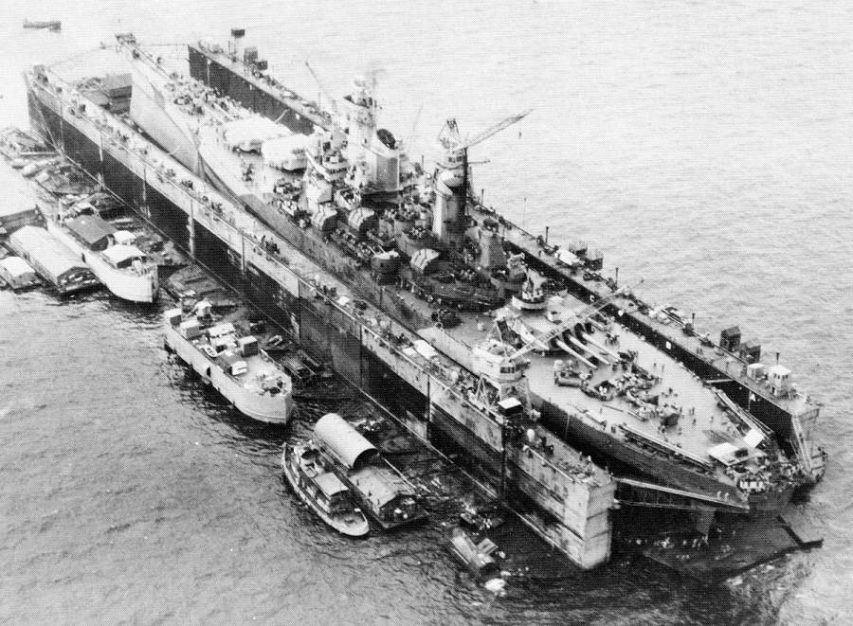I’d never heard of these massive mobile drydock facilities before:

USS Iowa (BB-61) in a floating drydock at Manus Island, Admirality Islands, 28 December 1944. (via Wikimedia)
The United States Navy, during World War 2, decided to create a temporary forward base utilizing service stations; these stations meant the United States Navy could operate throughout the huge Pacific Ocean for more sustained amounts of time.
Creating these pretty much meant they could have a major naval base within a short distance of any operation carried out in the area. The base was able to repair; resupply and refit, meaning fewer ships had to make the journey to a facility at a major port, which allowed them to remain in the Pacific for up to a year and beyond.
These stations were officially named Advance Base Sectional Docks (ABSDs) and were put together section by section. Each part was welded to the next once in their correct position.
There were two different sizes of floating docks created, the largest ones were created using ten sections and could lift 10,000 tons each – being 80 feet wide and 256 feet long. Once these sections were welded together, it became a fully assembled dock that was a whopping 133 feet wide, 827 feet long and could lift up to 90,000 tons.
This was more than enough lifting power for any ship within the Fleet.
The post also included this film, showing the USS Idaho being moved into an ABSD at Esperitu Santo in August, 1944:
Published on 7 May 2015
On August 15, 1944 the mighty battleship Idaho arrived at Espiritu Santo in the Pacific and slipped into a floating dry dock so that emergency repairs could be made to the ship’s blisters. This special film — likely made by the crew of the battleship’s observation aircraft — documents the activities as the ship is maneuvered into position. The dry dock shown is likely one of the Large Auxiliary Floating Dry Docks (AFDB), probably AFDB/ABSD-1. This was constructed in sections during 1942 and 1943 at Everett Shipbuilding Co., Everett, WA., by the Chicago Bridge & Iron Co., Eureka, CA., the Pollack-Stockton Shipbuilding Co., Stockton, CA., and Chicago Bridge & Iron Co., Morgan City, LA. During World War II ABSD-1 was assigned to the Asiatic-Pacific Theater and towed to Espiritu Santo in the New Hebrides and assembled for service. Later it was disassembled and towed to Manicani Bay, P.I. and reassembled for service by September 1945.
USS Idaho had been damaged during long days of combat that began with the bombardment of Saipan in June. With the landing assault underway on 15 June, the battleship moved to Guam for bombardment assignments. As the American fleet destroyed Japanese carrier air power in the Battle of the Philippine Sea from 19–21 June, Idaho protected the precious transport area and reserve convoys. After returning to Eniwetok from 28 June to 9 July, the ship began preinvasion bombardment of Guam on 12 July, and continued the devastating shelling until the main assault eight days later. As ground troops battled for the island, Idaho stood offshore providing vital support until anchoring at Eniwetok on 2 August.
After repair, Idaho‘s mighty guns were needed for the next giant amphibious assault on the way to Japan. She sailed from San Diego on 20 January 1945 to join a battleship group at Pearl Harbor. After rehearsals, she steamed from the Marianas on 14 February for the invasion of Iwo Jima. As Marines stormed ashore on 19 February, Idaho was again blasting enemy positions with her big guns, and fired star shells at night to illuminate the battlefield. She remained off Iwo Jima until 7 March, when she underway for Ulithi and the last of the great Pacific assaults – Okinawa.
At the end of the conflict Idaho made her triumphal entry into Tokyo Bay with occupation troops on 27 August, and was anchored there during the signing of the surrender on board the Missouri on 2 September. Four days later she began the long voyage to the East Coast of the United States, steaming via the Panama Canal to arrive at Norfolk on 16 October. She decommissioned on 3 July 1946 and was placed in reserve until sold for scrap on 24 November 1947 to Lipsett, Incorporated, of New York City.



